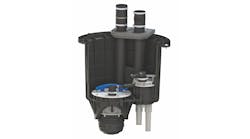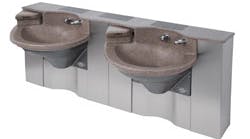Editor’s note: Part 1 of our coverage of Greenbuild ran on pg. 1 of our December issue.
PHOENIX — Greenbuild is turning into a top venue for plumbing-heating-cooling manufacturers and practitioners alike. Many plumbing and heating manufacturers, who likely would not have been here just three years ago, exhibited at Greenbuild 2009.
T&S Brass showed its low-flow pre-rinse spray valves that flow at just 0.65 GPM at 60 psi. The commercial dishwashing sprays use 60% less water than even EPA act-compliant valves. According to T&S, potential water savings are as much as 100,000-gal./year.
Watts Water Technologies had a wide-ranging green story to tell attendees. Its hot water recirculating systems can save thousands of gallons of water per year by providing instant hot water to sinks and showers. Water pressure reducing valves regulate water pressure to buildings and homes, saving up to 30% per year. For water quality and conditioning, Watts reverse osmosis systems, unlike typical RO filtration systems that waste 4-12-gal. for every gallon produced, recycle wastewater produced in the filtration process to provide a zero waste RO system. OneFlow anti-scale systems eliminate the need to introduce salt and chemicals. Radiant heating systems have been shown to reduce operating costs between 20% and 40%. The firm’s manifold and control technologies are used in solar, geothermal and solid fuel heating systems.
Aquatherm showed its green (literally) polypropylene pipe for potable water, chilled water, hydronic heating and industrial applications. The rigid pipe is heat fused. The company notes that the price of polypropylene is stable compared with steel or copper, lessening uncertainty at bid time. The pipe is lightweight and the heat fusion method provides a leak-proof joint. Heat fusion also does not release any volatile organic compounds. The material is resilient and resists damage at the jobsite.
The Plumbing Manufacturers Institute shared a booth at Greenbuild with the Alliance for Water Efficiency. “Our partnership with AWE started with the Alliance’s formation,” said PMI Executive Director Barbara C. Higgens. “PMI is a charter member in AWE and we represent 12 shared members. Early this year, our organizations joined with three others to establish the Plumbing Efficiency Research Coalition. We value this important relationship as we work together to achieve our vision. We’re pleased to be at Greenbuild with AWE.” The PERC’s first research project is investigating drainline carry with 1.28-gpf toilets.
Toto showed its EcoPower smart sensor technology, which is now available for residential faucets. The EcoPower generates its own power from a small internal turbine every time the water is turned on. A solid core manganese dioxide lithium battery serves as a back-up power source. The technology uses an instantaneous pulse of infrared light to determine hands’ presence before discharging water. It also records its own daily usage for a full week; then, during periods of infrequent use, EcoPower automatically reduces its infrared pulse frequency to conserve electricity. Its predetermined flow rate metes out 0.17-gal. per 10-second cycle, which is 32% below the 0.25 gallons-per-cycle baseline set by the federal government for high-efficiency faucets.
Acorn Engineering presented its Acorn Vac vacuum plumbing system for commercial, institutional, industrial and healthcare facilities. In addition to its traditional stainless steel fixtures, the company has introduced a porcelain toilet for high-rise residential or hotel applications. Toilets flush on just 0.5-gpf because of the vacuum and small diameter piping system. Acorn’s Master-Trol computer control allows the user to control how often and how long each valve can be open. Water flow to an unoccupied hotel room, for example, can be shut off, preventing flooding and water waste.
Bradley introduced its Advocate Lavatory System, the first lavatory system that provides soap, water and hand drying all in one space. The lavatory is made from recycled solid surface materials. The faucet flows 0.38 GPM and all the electrics are powered by a built-in photovoltaic panel. The system is available in various configurations up to 90-in. wide and multiple sinks heights are available.
Energy Alternatives introduced its Greenward Ridge Vent System that incorporates PEX tubing into the ride vent of the roof to take advantage of hot attics and roof surfaces to heat domestic hot water. The system comes with a storage tank, expansion tank, low speed circulator and controls. It uses a non-toxic anti-freeze, so the tank only needs a single-wall heat exchanger.
Daikin showed off its Daikin Altherma air-to-water heat pump system that can provide cooling and heating, including radiant floor heat, and domestic hot water. The R-410a system offers COPs between 3.0 and 5.0 and comes in either split system or a “monobloc” version in which all components are located within the outdoor unit. The Daikin Altherma can be installed in a variety of configurations, mating it with electric backup heat, or a boiler or solar thermal collectors. Daikin provides the domestic water tank, solar kit, room thermostats and a “simulator” software program that helps sell the benefits of the system.
Sanyo introduced its ECO-i modular HVAC system for commercial applications, including office and industrial operations. The package uses inverter technology, so it can flexibly handle varying loads, from computer rooms to conference rooms. As many as 40 indoor systems can be connected to one outdoor unit.



